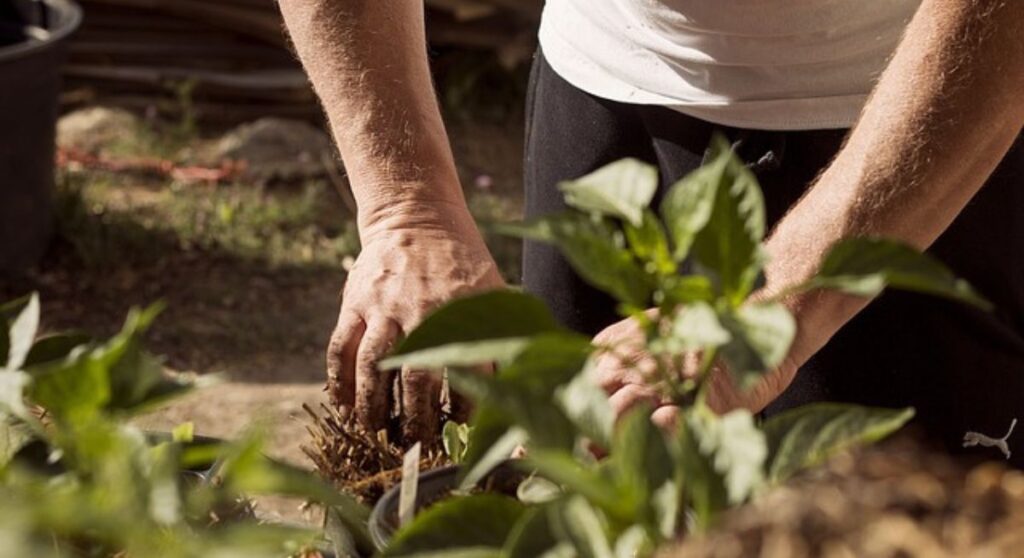Introduction:-
Top 10 Benefits of Companion Planting for a Thriving Harvest

Gardening is more than just a hobby; it’s a way to grow fresh, organic produce while creating a harmonious balance with nature. However, one of the biggest challenges gardeners face is controlling pests without relying on harmful chemicals. Enter companion planting—a time-tested method that can naturally boost your garden’s health and productivity without the need for pesticides.
In this guide, we’ll explore the benefits of companion planting and how it can help you achieve a thriving, pesticide-free harvest.
What is Companion Planting?
Companion planting involves the thoughtful arrangement of various plant species to promote their growth together, boost overall yield, and keep pests at bay. By learning about the interactions between different plants, you can cultivate a thriving ecosystem that benefits your garden’s health. Some plants naturally ward off pests, while others enhance soil quality or draw in helpful insects such as pollinators. The secret lies in choosing the right plant pairings to strike a harmonious balance between protection and productivity.
What are the 10 benefits of companion planting for organic gardening?
Benefits of Companion Planting

Companion planting is a gardening strategy that involves growing different types of plants in close proximity to one another for mutual benefits. This approach is particularly advantageous for organic gardening, as it promotes healthier plants, improves soil quality, and aids in pest management without the use of synthetic chemicals. Here are 10 significant advantages:
1. Natural Pest Control
• Some plants have the ability to naturally ward off pests. For instance, marigolds can keep aphids at bay, while basil is known to deter mosquitoes and flies, reducing reliance on chemical pesticides.
2. Enhanced Pollination
• Companion plants such as lavender and sunflowers attract helpful pollinators like bees and butterflies, which can lead to better fruit and vegetable yields.
3. Better Nutrient Absorption
• Certain plants, particularly legumes like beans and peas, enrich the soil by fixing nitrogen, benefiting nearby plants and enhancing overall soil fertility.
4. Optimized Space Usage
• By combining crops with varying growth patterns (like deep-rooted carrots alongside shallow-rooted lettuce), you can make the most of your garden space and increase your harvest.
5. Healthier Soil
• Plants like clover and buckwheat are excellent for preventing soil erosion and boosting organic matter, which is essential for organic gardening practices.
6. Natural Weed Control
• Ground-cover plants such as squash or creeping thyme can cover the soil, blocking sunlight and inhibiting weed growth, which reduces the need for manual weeding.
7. Climate Regulation
• Taller plants, like corn, can provide shade and protection for smaller, more sensitive plants that require shelter from intense sunlight, heat, or wind.
8. Higher Crop Production
• When companion plants are paired wisely, they can enhance each other’s growth. The “Three Sisters” method (corn, beans, and squash) is a classic example where each plant supports the others.
9. Support for Biodiversity
• A diverse array of plants fosters a balanced ecosystem, attracting beneficial insects and birds that help control harmful pests, leading to a more resilient garden.
10. Flavor and Growth Enhancement
- Certain herbs like basil, when planted with tomatoes, are believed to enhance the flavor of the tomatoes while boosting growth, making the harvest more enjoyable and abundant.
Companion planting aligns with the principles of organic gardening by fostering a self-sustaining and environmentally friendly ecosystem.
Top Companion Plants for a Pesticide-Free Garden
1. To maximize the benefits of companion planting, it’s important to choose plants that complement each other. Here are some excellent companion plants that can help ward off pests and enhance your garden’s yield:
• Marigolds: These adaptable flowers are effective at repelling various pests, such as nematodes and aphids. Position them alongside tomatoes, beans, and peppers for natural pest defense.
• Basil: Not only does basil improve the taste of tomatoes, but it also keeps mosquitoes, aphids, and whiteflies at bay. For optimal results, plant it near tomatoes, peppers, or eggplants.
• Garlic: The potent aroma of garlic is a deterrent for pests like aphids, slugs, and root maggots. It’s an excellent choice to plant near roses, lettuce, and carrots.
• Beans: Beans enrich the soil with nitrogen, making them fantastic companions for nutrient-hungry plants like corn and squash. They promote growth while enhancing soil health.
• Nasturtiums: These vibrant flowers attract aphids, diverting them from your vegetables. They also repel squash bugs and beetles, making them ideal companions for cucumbers, squash, and broccoli.
• Lavender: With its lovely scent, lavender draws in pollinators while keeping pests like moths, fleas, and whiteflies away. Plant it near cabbage, lettuce, and other leafy greens for both pest management and pollination advantages.
How does companion planting reduce the need for harmful pesticides?
Companion planting minimizes the reliance on harmful pesticides by utilizing the natural interactions between plants to repel pests and attract helpful insects. Here’s how it functions:

1. Natural Pest Deterrents
• Some plants release chemicals or strong fragrances that keep harmful insects at bay. For instance, marigolds give off a scent that repels nematodes and aphids, while basil is effective against mosquitoes and flies. These natural deterrents create a protective barrier, lowering the number of pests that threaten the crops.
2. Attracting Helpful Predators
• Certain plants, like dill, fennel, or alyssum, draw in predatory insects such as ladybugs, lacewings, and parasitic wasps, which feed on pests like aphids, caterpillars, and whiteflies. This natural predator-prey dynamic helps manage pest populations without resorting to chemicals.
3. Confusing or Masking Pests
• Some companion plants can confuse pests by hiding the scent of the main crop. For example, planting onions or garlic near carrots can obscure the smell of the carrots, making it difficult for carrot flies to find them. This helps prevent pests from targeting the primary crops.
4. Trap Crops
• Certain plants, referred to as trap crops, lure pests away from the main crops. For example, nasturtiums are often used to attract aphids away from vegetables like tomatoes or peppers. The pests focus on the trap crops, leaving the primary crops unharmed.
5. Disrupting Pest Life Cycles
• By incorporating a variety of plants, companion planting can interrupt the life cycles of pests. Monocultures (large areas of a single crop) are more vulnerable to infestations because pests can spread easily. Diverse plantings make it more challenging for pests to find their preferred hosts and thrive.
6. Promoting Healthy Plant Growth
• Companion plants can boost the health and vitality of their neighbors, making them more resilient to pests. For instance, borage is believed to enhance the defenses of plants like strawberries and tomatoes, making them less appealing to insects.
7. Creating Homes for Helpful Insects
• Companion plants serve as both shelter and food for helpful insects that feed on garden pests. For example, plants like coriander, lavender, and daisies attract pollinators and beneficial insects such as hoverflies, which play a role in pest control.
8. Using Companion Plants to Ward Off Diseases
• Some plants can aid in disease prevention by enhancing airflow or repelling insects that carry diseases. Chives and garlic, for instance, can help protect roses and tomatoes from fungal infections.
By nurturing a natural ecosystem where helpful insects flourish and pests are managed, companion planting reduces the need for chemical pesticides and supports a healthy, sustainable garden.
Conclusion
Adopting companion planting can lead to a thriving and healthier garden while steering clear of harmful pesticides. This environmentally friendly method not only enhances your yield but also contributes to environmental protection and promotes sustainable gardening. Regardless of your gardening experience, the advantages of companion planting make it an essential technique to explore for any garden.
References
1. Rodale’s Organic Life – “Understanding Companion Planting”
This resource provides valuable information on how companion planting can boost garden productivity, enhance soil quality, and naturally deter pests without resorting to harmful chemicals.
Rodale’s Organic Life
2. Mother Earth News – “Using Companion Planting for Pest Management”
A thorough exploration of different companion planting techniques, emphasizing the advantages of natural pest management and increased crop yields.
Mother Earth News
3. The Old Farmer’s Almanac – “Guide to Companion Planting”
An extensive guide on companion planting that details which plants thrive together and how they contribute to a healthier garden ecosystem.
The Old Farmer’s Almanac
4. Gardener’s Supply Company – “Advantages of Companion Planting”
This guide offers useful tips on leveraging companion planting to minimize pests and boost garden productivity.
Gardener’s Supply Company
5. Sustainable Gardening Australia – “Companion Planting for Eco-Friendly Pest Control”
This article emphasizes sustainable gardening methods, including companion planting, to foster a balanced and environmentally friendly garden.
Sustainable Gardening Australia

